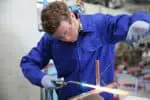Welding is a complicated and tough process that incorporates a variety of factors such as diverse materials, heat, electricity, and oxidation. With so many things being involved, there is a potential that difficulties can arise that will result in weld failure.
Therefore, to properly complete a welding task, you must first learn about the metals that are suited for welding.
The best metals for welding are determined by the weld design, budget, the welder’s knowledge and ability, and the welding procedure to be employed.
Almost any metal can be welded, although some are simpler to work with than others in terms of producing a high-quality weld.
However, if we have to name them, the best metals for welding would be:
-
-
- Steel/ Low Carbon Steel/Stainless Steel
- Aluminum
- Copper
- Nickel Alloys
- Magnesium
- Titanium
-
Let us look into all of these metals in detail.
1.) Steel/ low carbon steel/ stainless steel
Welders are familiar with the strength of steel. Different steels need different types of heating and welding. Steel is an alloy metal composed of iron and 2% additional metal elements.
Since steel with a high carbon content is stronger, low carbon steel is easily weldable. Because it includes less than 0.3% carbon and up to 0.4% manganese, low-content carbon steel is very ductile.
Stainless steel is designed to prevent corrosion and keep the metal clean. This is accomplished by adding 10-30% chromium to other steel components such as iron.
2.) Aluminum
While it is more difficult to weld than low carbon steel, aluminum may be welded with ease provided the correct information and procedures are used.
Aluminum is a metal that is similar to stainless steel. And in comparison to other metals, it is non-corrosive in nature.
Heat is quickly carried away from the weld due to aluminum’s strong thermal conductivity. And to provide the requisite heat, equipment with a greater welding current may be required.
3.) Copper and brass
Copper and brass have great corrosion resistance, making them suitable for a wide range of welding applications. The welder must account for any alloys in the material that produce fractures or oxidation during the welding process.
Copper is particularly easy to weld, resulting in a considerably smoother and faster welding operation. Unlike welding aluminum, welding copper is simple and ideal for beginners.
Although the heat necessary to weld copper is roughly double than what is required to weld steel, the temperature of the heat is what makes it easy.
4.) Nickel alloys
Nickel welding is done with several nickel alloys that are accessible. The welding method for nickel alloy is quite similar to that of carbon steel.
Since the arc can penetrate thin-walled pipes, tubing, and tin gauge strips, this is employed while welding.
Because of the reduced weld hardening effect, this welding process is also used for high carbon steels. The material should be thoroughly cleaned by removing any oil, grime, and residue.
5.) Magnesium
Magnesium alloys are lightweight, even lighter than aluminum. The magnesium alloy absorbs vibration and is simple to cast. Because magnesium alloy and aluminum have the same melting point, they are fused in the same manner.
6.) Titanium
When a welder safeguards titanium against oxidation, he or she may employ it to produce strong and long-lasting results. Titanium requires complete shielding gas covering to give a high level of weld integrity.
Let us look at the chart below:
| Metal | Arc/Stick | MIG | Flux Core | AC TIG | DC TIG | Spot |
|---|---|---|---|---|---|---|
| Steel | √ | √ | √ | √ | √ | |
| Stainless Steel | √ | √ | √ | √ | √ | |
| Aluminum | √ | √ | √ | |||
| Copper/Brass | ||||||
| Magnesium | √ | |||||
| Titanium | √ |
The above mentioned metals are most commonly welded, no matter the difficulty level. These metals are weldable for a reason.
What makes metals weldable?
The American Welding Society defines weldability as, “The ability of a metal to be welded into a specific, adequately planned structure under the fabrication circumstances imposed and to function successfully in the intended service.”
Which means, weldability is the ease with which metals may be fused without generating faults in the completed product. Welding is possible with many metals, however some are simpler to weld than others.
In simple terms, weldability is defined as the ease with which a weld joint may be achieved, and it can be judged by the quality of the weld joint, as well as the work and expense necessary to produce the weld joint.
The weldability of a material is used to determine the welding procedure and to compare the final weld quality to that of other materials.
There are several factors that affect weldability of a metal. We have listed some of the most important ones:
1.) Metallurgy: It is the science of heating or manipulating metals in order to achieve desired qualities or structure.
2.) Weld Preparation: Weld preparation is a collection of practices used prior to welding to avoid weld errors. One technique is to clean the base metal prior to welding.
3.) Welding Process: There are over 60 different welding techniques. Several aspects distinguish them, including how heat and pressure are applied, how much heat and pressure are utilised, and the type of equipment used.
4.) Joint/Connection Design: The combination of the dimensions necessary for the welded joint.
5.) Melting Point: The temperature at which a solid material must be melted or fused. Weldability improves when a metal has a mild melting point.
6.) Resistance to electricity: The resistance of a metal to the flow of electrical current. Metals having a high electrical resistance need more heat energy to weld, making them unweldable.
How Can Weldability Be Improved?
The heating and cooling cycles that are inherent in most types of welding can cause pressures and strains in the weld. They also have an impact on the metal’s physical, chemical, and metallurgical alterations.
And when these changes make a metal susceptible to poor weldability, modifications can be made to enhance weld quality.
How can weldability be improved?
Yes, the weldability factor of a metal can be improved so that the metal utilised will successfully create good quality welds.
However, there are some points to consider in order to improve the weldability of metals-
1.) Shielding Gas: Some metals, such as copper and aluminum, require a shielding gas during welding to protect them from air impurities and corrosion. Choosing the suitable shielding gas for the job and using it correctly will reduce the likelihood of weld faults.
2.) Welding Procedure: The number of welds, their duration, and the size of the weld bead may all affect weld quality.
3.) Welding Method: Welding charts with detailed information are available for use as a reference when deciding which process to utilise for a metal.
4.) Filler Metal: Using the incorrect filler metal might result in weld flaws such as fractures and porosity. A common rule of thumb is to use a filler metal that is stronger than the base metal.
5.) Preheat and post heat: Brittle metals are susceptible to breaking during welding. This difficulty can be alleviated by heating the metal both before and after welding.
While all metals can be welded, certain metals fuse more easily than others and some metals are more commonly used.
However, knowing the elements that determine weldability and how to enhance it may help a welder consistently make strong and sound welds.
Conclusion
As we know by now that there are various metals that can be welded, however, it isn’t about the easiest metal to weld. It is more about how the finished product turns out to be. You need your finished product to be strong and aesthetically pleasing.
In this article, we have covered the metals that are most commonly employed for welding processes.







